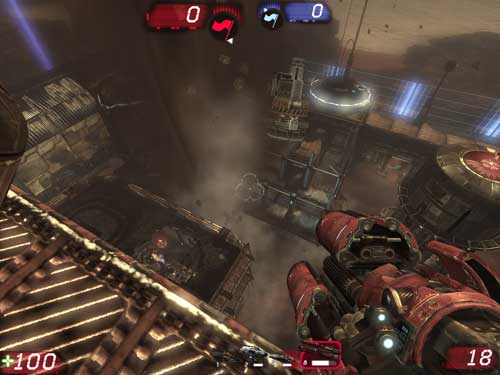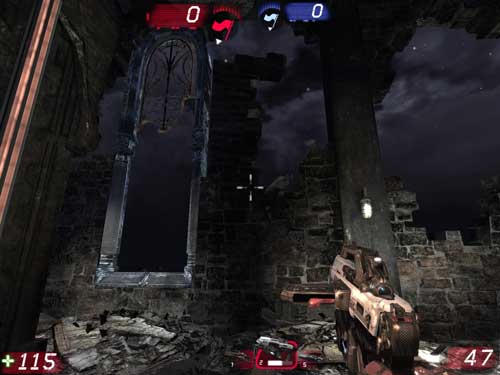PhysX’s Big Break? Unreal Tournament 3 PhysX Performance
by Ryan Smith on December 14, 2007 12:00 AM EST- Posted in
- GPUs
AGEIA’s Mod Pack & The Test
Unfortunately the PhysX situation in Unreal Tournament 3 is a little more convoluted than we would like. While the engine is capable of first-order physics using PhysX, because the game is not solely a technological showcase, there aren’t any maps that ship with it that heavily utilize physics interactions. The game does use the PhysX libraries to run some physical simulations, but other than a handful of situations such as cloth simulations, there isn’t much obvious physics work taking place. It’s not the eye-candy feasts that we’ve seen with other PhysX hardware enabled games, but this is also a benefit: UT3’s PhysX hardware support doesn’t enable any extra eye-candy, it solely offloads the physics work to the PPU. This will be an important distinction going forward as we’re going to be looking solely at issues of performance and not non-quantifiable (and performance-impairing) aspects of eye-candy.
AGEIA, apparently having taken charge of promoting PhysX on Unreal Engine 3, has been developing a mod kit to help modders/developers integrate physics situations in to their maps, and as a part of that kit has released a pair of maps that make heavy use of physical interactions as part of the gameplay. This makes UT3 straddle the line between being or not being a real/meaningful PhysX enabled game since as far as we know these are the only maps for the game that use first-order physics. This means that the biggest selling point for using a PhysX card with UT3 becomes the mod and not the game itself, but for the purpose of this article we’ll take the situation as it’s presented.
Along with our benchmarks of the shipping UT3 maps, we’ll include both of AGEIA’s mod maps in our benchmarks. The first map is CTF-Tornado, a map featuring a tornado that moves around unanchored objects, rips up some buildings, and sucks up unsuspecting players. As far as physical interactions goes this map is only moderately heavy, an intentional decision for allowing it to be playable without the PhysX PPU.
The second map is CTF-Lighthouse, AGEIA’s crown jewel out of their map pack, making very heavy use of physical interactions. This map features numerous destructible walls and floors, showcasing the direction AGEIA wants to push developers to go with physics. It’s also a pig of a map, as we’ll see it’s not playable at all without the PhysX PPU.
We’ve had to deviate a bit from our normal benchmarking routines, since UT3 does not support demo recording with AGEIA’s maps, presumably because of the first-order physics used. Instead we’ve gone with botmatches for all of our tests (including the normal UT3 maps) which offer variable results but also run the full client physics simulation process, ensuring that we’re capturing something fairly close to real world performance under repeatable circumstances. The use of bots means some CPU time is spent dealing with them, but given what we know about Unreal Tournament 2004’s player statistics, playing against bots turned out to be rather popular, so we don’t believe our results to be all that far fetched.
Every map we tested was run at 1600x1200 (our realistic scenario) and 800x600 (our anti-GPU bottlenecking scenario) both with the PhysX hardware enabled and disabled, on both a high-end QX6850 processor and a mid-range E6600. Varying all 3 processing components will allow us to reasonably isolate any bottlenecks in performance. All tests were run 3 times to reduce variability and the results averaged.
| Software Test Bed | |
| Processors | Intel Core 2 Quad QX6850 (3.00GHz/1333MHz) Intel Core 2 Duo E6600 (2.40GHz/1066MHz) |
| RAM | G.Skill DDR2-800 (2x2GB) |
| Motherboard | Gigabyte GA-P35-DR3R (Intel P35) |
| System Platform Drivers | Intel 8.1.1.1012 |
| Hard Drive | Maxtor MaXLine Pro 500GB SATA |
| Video Cards | 1 x GeForce 8800GTX |
| Video Drivers | NV ForceWare 169.12 |
| Power Supply | OCZ GameXStream 700W |
| Desktop Resolution | 1600x1200 |
| Operating Systems | Windows Vista Ultimate 64-Bit |












29 Comments
View All Comments
marbles - Saturday, December 22, 2007 - link
We represent a very small fraction of PC gamers and users and even many of us are not sure we'll ever buy a PPU card. From someone who has repaired and built PCs over the years and has spent hours explaining the difference between "free" onboard graphics and 700.00 graphics cards I don't want to have to explain a PPU.Look at the Geo mod capability in Red Faction (7 yrs ago) and the physics incorporated into the Source engine (3 yrs ago). They all came "free" because of the willingness of the game maker to make this work and keep the game playable on a reasonable PC. Look at Fracture out next year for the PPU-less 360 and PS3.
The quality of popular PC franchises are already being compromised for consoles so there is little hope that a PC specific PPU will ever be required to play any game. I think AGEIA's best hope for the PC is middleware and having their technology integrated into main boards or graphic cards.
Are these two UT3 maps available for the consoles?
perzy - Wednesday, December 19, 2007 - link
The CPU is dead! The future is dicrete processors.The heat wall is a not a bump in the road, it IS a wall.
Look at chipzilla that had a concussion rammin it's head in the wall, spent 4-5 years redesigning then pentium m to core 2 duo.
AMD bought a gpu-manufacturer that still has a few years of developing before the heat wall and Intel bought Havok and is quietly gearing up it's own dicrete gpu-dept.
Nvidia seems to be working on worlddomination on their own, or just trying to boost their own value before being bought by chipzilla.
Sure you can have maybe 16 cores (heatwall + power envelope) on a CPU but still they are slow and they dont have their own superfast dedicated ram.
So Ageia is right on the mark, how far they now seem to be from it.
0roo0roo - Sunday, December 16, 2007 - link
give me all the physics you can on a 2 or 4 core cpu and go on from there. a phyx card does nothing during normal use. its dead weight. i'd rather pay for a nicer cpu or gpu which are used in some way 100% of the time. there just isn't a killer game play app for the ppu. stacking boxes is already possible and not that compelling. developing a ppu only killer app game isn't really something i can see happening. while they wait for that miracle to come by cpus will creep up and surpass the card anyways:PFrancisbacon - Monday, December 24, 2007 - link
You're absolutely correct.Games developers will only take PPUs seriously once a lot of people have them, and this will only be the case once Nvidia and ATI start shipping graphics cards with PPUs on-board.
This is not too far off, Nvidia and ATI are both known to be working on including physics on their next generation of cards.
Buying a bodge-job like this, a PCI expansion card which actually offers very little in the way of power and only really affects one mainstream game in a very minor way is a total waste of money right now. It's far more sensible to upgrade your CPU and wait for physics-enabled graphics cards to come out.
On top of all this, I'm fairly certain exactly the same results could have been acheived by fully utilising all four cores of the CPU, but the Ageia modders chose not to, for obvious reasons.
Francisbacon - Monday, December 24, 2007 - link
You're absolutely correct.Games developers will only take PPUs seriously once a lot of people have them, and this will only be the case once Nvidia and ATI start shipping graphics cards with PPUs on-board.
This is not too far off, Nvidia and ATI are both known to be working on including physics on their next generation of cards.
Buying a bodge-job like this, a PCI expansion card which actually offers very little in the way of power and only really affects one mainstream game in a very minor way is a total waste of money right now. It's far more sensible to upgrade your CPU and wait for physics-enabled graphics cards to come out.
On top of all this, I'm fairly certain exactly the same results could have been acheived by fully utilising all four cores of the CPU, but the Ageia modders chose not to, for obvious reasons.
Sacher - Sunday, December 16, 2007 - link
Nice in-depth article. I'm wondering, what did you (Ryan) have the texture-detail and world-detail [advanced video] settings at?Does the physics load change when using different world-detail settings?
FITCamaro - Friday, December 14, 2007 - link
While performance didn't increase that much with the PPU on the real maps, did the game look better? You didn't answer this. If I get noticeable better effects with the PPU and the same performance as without, thats a win to me. If it just displays the same effects as without the PPU just faster, then no its not worth it.Physics is not about increasing the FPS of a game. It's about making it more realistic and immersive.
Ryan Smith - Friday, December 14, 2007 - link
We mentioned this elsewhere in the article, but the effects are the same. Enabling the PhysX hardware only offloads them to the PPU, it doesn't create any new effects.ET - Friday, December 14, 2007 - link
For a low end or old system, an inexpensive card which could offer a performance boost would have been welcome. However these tests show more of a performance gain on the quad core than the dual core. While this might mean that people with money to spare (high end quad core users) may be able to get even more performance for relatively little (compared to their CPU's price), low end buyers can't get as much of a boost.Which sounds to me backwards. If I could get a significant performance boost for my semi-old PC, I might have been more interested.
SuperGee - Sunday, December 16, 2007 - link
That is because a lowbudged game rig has several bottlenecks and if this is GPU holding back FPS, ofloading a not so bottlenck like CPU yields not much in such case.As most game tend to be GPU limited. And a old or low budged PC wil often be most limited on GPU.
A PPU isn't ment for offloading but for more Physics. This means a decent game-rig is needed to use a PPU properly with a physics load made for PPU.
A PPU is more ment for Physics enthausiast, early adopter, hardcore gamers or highbudged rigs. To play PhysX games in optimal settings.
The QC yield so much because the benched it with a less GPU stressing setting. Wich is not the way people game with a high-end game PC.